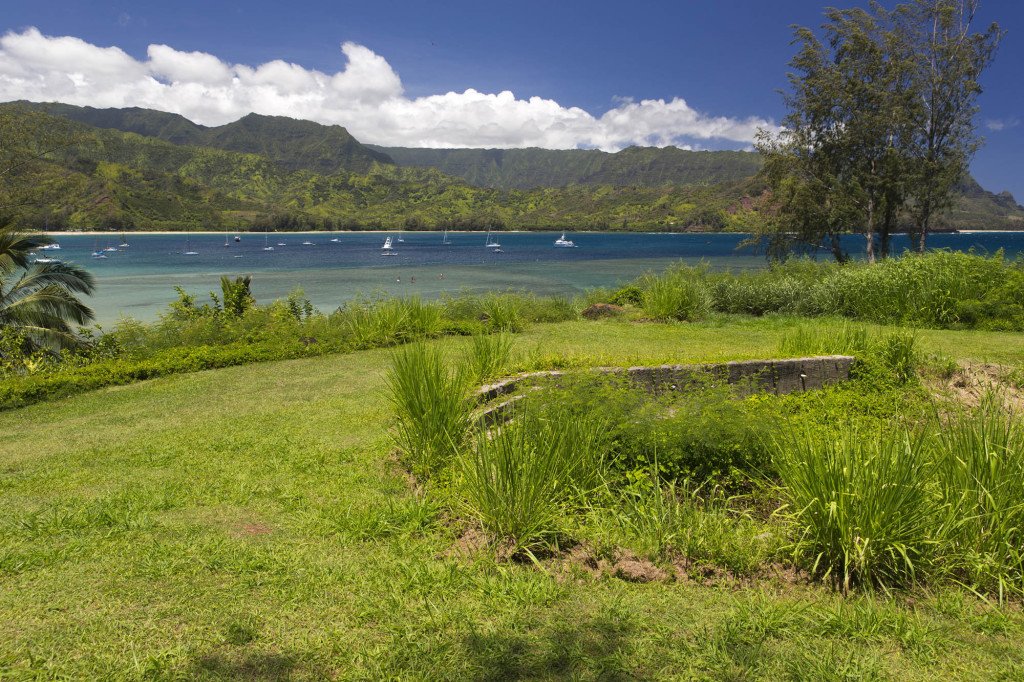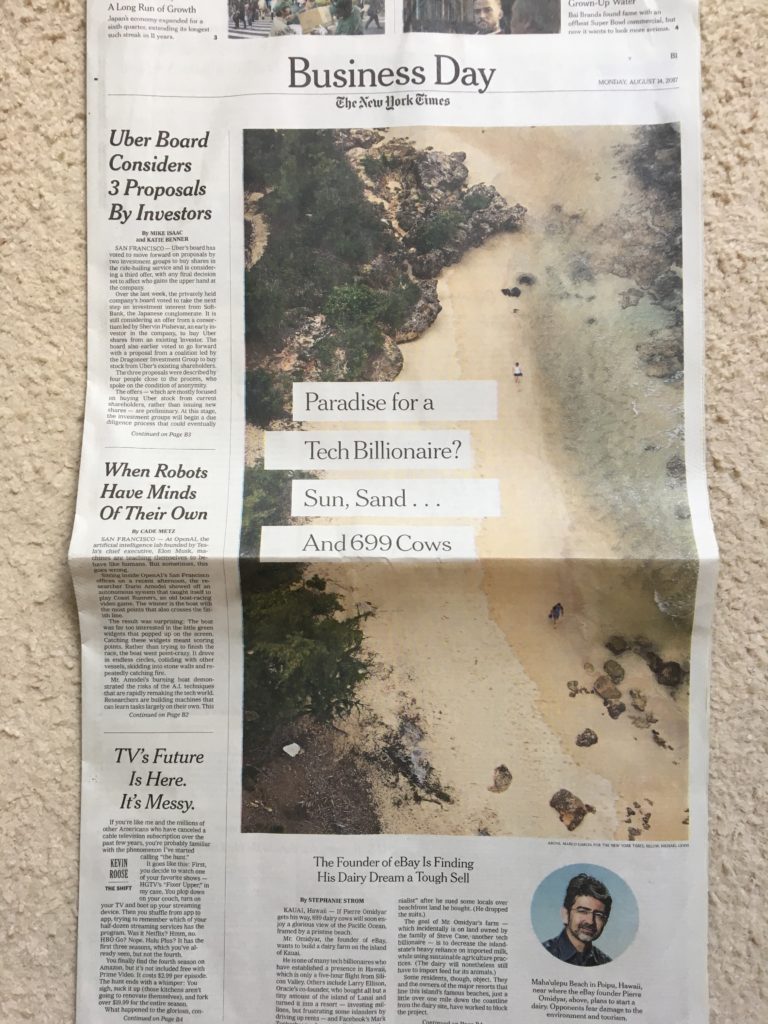Hawaii is a wonderful place to live. Near perfect weather 365 days a year, beaches, bikinis, mai tais. Just paradise, as some might say. But we’re cursed with limited land leading to sky high home prices and a general high cost of living. Yes, milk does cost $8.00 a gallon and the average cost of a single family home is well over half a million dollars. And with paradise, everyone wants a slice and people are willing to pay for it. Developers are trying to cover every inch of Oahu with suburban sprawl and swallow up the air with glass and steel towers. Currently, developers are planning to build up to seven high rises in the Kakaako area. The soothing sounds of rolling ocean waves and the rustle of palm trees have been replaced by the beep beep beeps of trucks backing up on the multiple construction sites around town. The old joke of the state bird being the Hawaiian (construction) crane is again, reality.
Progress can be a helluva thing! Not many of us want to see Hawaii change drastically but development means new jobs, spending, new homes, tax revenue, investment, and other “positive” changes. Many old neighborhoods in Honolulu are run down and well-planned development can bring new vitality to the slumping city. Yet developers only want to build luxury residences for those who can afford it. High labor and material costs, shipping, land value all force developers to think luxury rather than affordable. Many companies are lobbying the State and the land holders to rezone no longer used farm land so they can build homes. Where there was once pineapple and sugarcane, developers want to put miles and miles of cookie cutter homes…many which will be priced too high for the average working family in Hawaii. The union workers who will be hired to build of these condos and homes won’t be able to afford what they built. More than 85 percent of planned Ritz-Carlton luxury condo in Waikiki sold during a private weekend sale with prices ranging from $750,000 to $15 million. Brokers had clients in Tokyo, Shanghai, and Europe. I would assume very few locals, if any, were able to purchase even the lowest priced units. The American Dream for many born in Hawaii will never be realized in their homeland.
As Oahu struggles under the weight of all their construction, the outer islands have their own growth and development issues. Maui, Kauai, and the Big Island have mega resorts and ultra rich neighborhoods, isolated and vastly expensive. Some would argue the best of the outer islands has been swallowed by developers, gated and closed off to locals. Although State laws demands public access rights to any beach front area, many developers simply limited public parking or placed lots far away from any access points. Many claim the rich have privatized Hawaii’s beauty and indeed many projects have but they’ve also protected pristine areas from further construction as well. Some local residents have not always been the best stewards of the land. Tourist and rich land owners don’t often smash green Heineken bottles on the rocks, leave garbage strewn in the parks, nor off-road in 4×4’s all over the beach. Recently a young boy on Oahu severely burned his hands because someone improperly disposed of hot coals from a BBQ by burying them in the sand. “Malama ka a’nia,” as some would say, isn’t always practiced.
In July, I worked on a job with writer Jim Carlton and the Wall Street Journal on a controversial development project on a ridge overlooking Hanalei Bay on Kauai. The developer is eBay founder Pierre Omidyar and his investment firm wants to build 30 plus luxury homes on land already zoned for development on the Princeville ridge. The project would develop the homes which would sit across the river from popular Black Pot Beach. The community fears the new development would be an eyesore and some feel the rich might demand restrictions at the beach and land fronting the property. Many just don’t want any more development on their tranquil island paradise.
The ridge, once a Club Med in the late 1970’s, has foundation work built from a prior development plan but the project went bankrupt before any of the units were built. The ridge now sits undeveloped and overgrown with evasive species covering the area. Omidyar’s plans to also restore an ancient Hawaiian fish pond along with eradicating many of the evasive species and helping restore and protect the environment. The fish pond has been ignored and abandoned for decades and its a welcome sign Omidyar’s wants to help the community but the anti-development crowd feel its a band aid for a housing project many do not want.

The community on Kauai last fought the Hawaii Superferry, an inter-island ferry which transported people and vehicles. The protesters feared additional traffic and population on their already taxed communities and wanted to keep Kauai from being further spoiled. From the outside, it seemed many malahinis, or newcomers, were the most vocal as some local residents welcomed the Superferry as an alternative to the monopoly of the airlines and shipping companies.
Those who support the development see it as needed jobs for the community. Kauai’s isolation, the State of Hawaii’s strict business regulations, and powerful unions have kept many businesses away. Construction, service, and other related jobs can help ensure many Kauaians can afford to stay in the area. Omidyar’s project could employ many for generations. The State and local community also benefits as tax revenue will help improve the infrastructure and schools. Everyone could possibly benefit from his development project. However, the community remains divided as the development of Hanalei Bay will drive already high land prices higher leading to higher property taxes. Many old time residents have been forced to leave the area due to an ever growing tax burden.
But sadly, a new wave of newcomers, tourist and new residents, are already changing the idyllic nature of Hanalei. There’s more traffic, more construction, more noise. Those old time residents are slowly being uprooted by new faces more suited in Laguna Beach. This new wave of malahinis can afford to pay the higher taxes and cost of living. Plate lunch joints and cans of Bud are making way for tapa bars, bottles of merlot, and art galleries. There seems to be more dredlocked trust fund kids surfing the waves at Hanalei Bay than the locals who grew up in the area.
Change is inevitable. If something is good and it gets out, everyone wants to go there. Red Hook, Austin, Hanalei. And I think its human nature to want to shut the door behind you once you get in. Many pro development people in the area know the jobs will help but feel those against it are the same newcomers who are against anything that might spoil their slice of paradise. That crowd already secured their views, their properties, their way of live and now want to limit who can now come in. Ironically, many of those in the anti-development crowd forced change when they first arrived.
But when you experience Hawaii, whether it’s in Kauai or Oahu, you quickly see how wonderful a place the Islands can be. Everyone knows your name in Hanalei. People don’t lock their doors. Neighbors will help neighbors in that small town way. That’s the allure. Its an unspoiled paradise where the sunsets are magical every night. Yet every year I’ve gone to the area, I can’t help but to see more and more tourist, more and more new residents, more and more development. Everyone wants a slice.
The genie is out of the bottle and the land has gotten away from the locals.
We’d all like to keep all of Hawaii pristine but at what cost? Hawaii is paradise but its a prison if you can’t afford it. And its a beautiful prison to many locals who can’t. Too many malahinis show up with money who can afford it and force the change. The locals just can’t keep up. The anti development crowd can continue to fight changes and they might win this battle against Omidyar but there will be many more to come. It would be a paradise if many could live their lives growing, sharing, trusting, and enjoying a wonderful slice of Hawaii but everything has a price tag.



